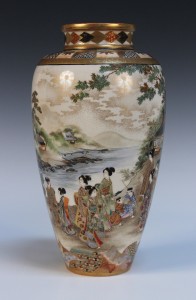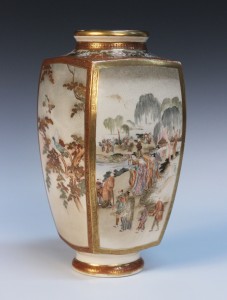
During the Meiji period (1868-1912) Japanese Satsuma captured the imaginations of Western collectors with its opulent, jewel-like decoration.
For more than two hundred and fifty years Japan had lived in relative isolation from the outside world. American gunboat diplomacy, instigated by Commodore Perry in 1853, opened up Japan for trade with the West. The Japanese did not wish to be a subjugated nation and turned to their rich tradition of arts and crafts to articulate their place in the world as a civilized nation. It was from these traditions that Japanese manufacturing began to emerge alongside the desire to benefit from trade.
Satsuma ceramics met with great success at the Paris Exposition Universelle of 1867. In contrast to earlier pieces Satsuma from the Meiji period was elaborately decorated and predominately produced for export. After its success in Paris this finely conceived style was adopted by the ceramic artist, Kinkōzan Sōbei VI (1824-1884). He brought it to Kyoto and the Awata district became the centre of Satsuma production. The wares produced here were similar in style and taste to the Satsuma produced in other towns and cities like Osaka and Yokohama. The extravagance of these designs contributed to its popularity in Western markets.

Satsuma had become an aesthetic term rather than denoting place. However, the personal styles of the leading painters was articulated through their skilful use of palette and brushwork. Amongst these artists were Kinkōzan, Ryozan and Kōzan, whose work can be seen here.
These three richly ornamented vases capture the essence of Meiji Satsuma. Borders and details are lavishly defined in raised gilding. The detail of the painting is jewel like.
Ryozan’s depiction of elegant women, known as bijin, and children playing in a landscape is typical of the scenes commonly found on Satsuma objects, as are the brocade borders. The vase was decorated for the Yasuda Company. The Kinkōzan vase of baluster square form is similarly decorated with figurative and coastal landscape panels.

What was new in this Satsuma genre was the manner in which landscape imagery was employed to convey a narrative about Japan. Here bijin, and children play in realistic depictions of landscapes. These scenes intentionally capture Japanese life – past and present. They open a window onto an exquisitely serene world inhabited by the Japanese educated classes. These vases were 23.5cm high and sold at Toovey’s for £950 and £1100 respectively.
You often find bold depictions of Samurai heroes and rakan on Satsuma pieces like the reserve panels of the gourd shaped vase by Miyagawa (Makuzu) Kōzan (1842-1916). The opulent floral vignettes, simulated brocade borders and flowerheads are typical Satsuma motifs. Measuring 25cm in height the vase realised £1200 at Toovey’s.
The Meiji period witnessed Japan’s evolution from a feudal, closed society, under the rule of the military shoguns, towards its manufacturing modern era. Satsuma ceramics are a quintessential expression of the Meiji period which continues to delight the imaginations of western collectors and our sense of the exotic.
By Rupert Toovey, a senior director of Toovey’s, the leading fine art auction house in West Sussex, based on the A24 at Washington. Originally published in the West Sussex Gazette.